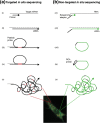Fourth-generation sequencing in the cell and the clinic
- PMID: 25031621
- PMCID: PMC4062057
- DOI: 10.1186/gm548
Fourth-generation sequencing in the cell and the clinic
Abstract
Nearly 40 years ago, DNA was sequenced for the first time. Since then, DNA sequencing has undergone continuous development, passing through three generations of sequencing technology. We are now entering the beginning of a new phase of genomic analysis in which massively parallel sequencing is performed directly in the cell. Two methods have recently been described for in situ RNA sequencing, one targeted and one untargeted, that rely on ligation chemistry. This fourth generation of sequencing technology opens up prospects for transcriptomic analysis, biomarker validation, diagnosis and patient stratification for cancer treatment.
Figures

References
-
- Lee JH, Daugharthy ER, Scheiman J, Kalhor R, Yang JL, Ferrante TC, Terry R, Jeanty SS, Li C, Amamoto R, Peters DT, Turczyk BM, Marblestone AH, Inverso SA, Bernard A, Mali P, Rios X, Aach J, Church GM. Highly multiplexed subcellular RNA sequencing in situ. Science. 2014;343:1360–1363. doi: 10.1126/science.1250212. - DOI - PMC - PubMed
LinkOut - more resources
Full Text Sources
Other Literature Sources

